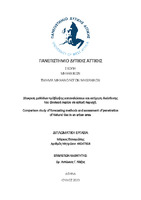| dc.contributor.advisor | Νάζος, Αντώνιος | |
| dc.contributor.author | Μάρκος, Παναγιώτης | |
| dc.date.accessioned | 2023-09-01T09:31:51Z | |
| dc.date.available | 2023-09-01T09:31:51Z | |
| dc.date.issued | 2023-07-17 | |
| dc.identifier.uri | https://polynoe.lib.uniwa.gr/xmlui/handle/11400/4986 | |
| dc.identifier.uri | http://dx.doi.org/10.26265/polynoe-4824 | |
| dc.description.abstract | Το φυσικό αέριο αποτελεί την καθαρότερη πηγή πρωτογενούς ενέργειας, μετά τις ανανεώσιμες πηγές, με την τιμή πώλησης του να είναι χαμηλότερη από αυτήν του πετρελαίου. Η εισαγωγή του στο ενεργειακό ισοζύγιο της Ελλάδας, επηρεάζει ολοένα και περισσότερους κλάδους της οικονομικής και της κοινωνικής ζωής, με αποτέλεσμα να είναι απαραίτητο να προβλεφθεί η κατανάλωση φυσικού αερίου σε μια περιοχή, ώστε οι εταιρείες διανομής να μπορούν να δημιουργήσουν το απαιτούμενο δίκτυο μεταφοράς και διανομής. Στην παρούσα εργασία θα μελετηθούν μέθοδοι πρόβλεψης των καταναλώσεων αιχμής σε μια αστική περιοχή. Αρχικά, γίνεται αναφορά στο φυσικό αέριο και παρουσίαση των ιδιοτήτων του, της προέλευσης του, του τρόπου μεταφοράς και διανομής του στην Ελλάδα, αλλά και του νομοθετικού πλαισίου που το διέπει. Στη συνέχεια, γίνεται αναλυτική και λεπτομερής παρουσίαση των μεθοδολογιών πρόβλεψης της κατανάλωσης αιχμής. Επίσης, παρουσιάζεται η περιοχή στην οποία θα γίνει η μελέτη με τα δεδομένα του πληθυσμού και νοικοκυριών να προέρχονται από την ΕΛΣΤΑΤ. Έπειτα, βάσει των μεθοδολογιών και των δεδομένων πραγματοποιείται υπολογισμός της ωριαίας κατανάλωσης αιχμής, που αποτελεί βασικό στοιχείο για τον σχεδιασμό και διαστασιολόγηση του δικτύου μεταφοράς και διανομής της περιοχής. Τέλος, πραγματοποιείται σύγκριση των αποτελεσμάτων που προέκυψαν και παρουσίαση των πλεονεκτημάτων της εκάστοτε μεθόδου. | el |
| dc.format.extent | 89 | el |
| dc.language.iso | el | el |
| dc.publisher | Πανεπιστήμιο Δυτικής Αττικής | el |
| dc.rights | Αναφορά Δημιουργού - Μη Εμπορική Χρήση - Παρόμοια Διανομή 4.0 Διεθνές | * |
| dc.rights | Attribution-NonCommercial-NoDerivatives 4.0 Διεθνές | * |
| dc.rights.uri | http://creativecommons.org/licenses/by-nc-nd/4.0/ | * |
| dc.subject | Φυσικό αέριο | el |
| dc.subject | Υγροποιημένο φυσικό αέριο | el |
| dc.subject | Διείσδυση φυσικού αερίου | el |
| dc.subject | Μεταφορά φυσικού αερίου | el |
| dc.subject | Διανομή φυσικού αερίου | el |
| dc.subject | Ωριαία κατανάλωση αιχμής | el |
| dc.title | Σύγκριση μεθόδων πρόβλεψης καταναλώσεων και εκτίμηση διείσδυσης του φυσικού αερίου σε αστική περιοχή | el |
| dc.title.alternative | Comparison study of forecasting methods and assessment of penetration of natural gas in an urban area | el |
| dc.type | Διπλωματική εργασία | el |
| dc.contributor.committee | Sakellariou, Evangelos | |
| dc.contributor.committee | Maitos, Antonios | |
| dc.contributor.faculty | Σχολή Μηχανικών | el |
| dc.contributor.department | Τμήμα Μηχανολόγων Μηχανικών | el |
| dc.description.abstracttranslated | Natural gas is the cleanest source of primary energy, after the renewable sources, with a selling price lower than that of oil. Its introduction into the energy balance of Greece affects more and more sectors of economic and social life, as a result to make it necessary to forecast the consumption of natural gas in a region so that distribution companies can create the required transmission and distribution network. In this paper, the methods of forecasting peak consumption will be studied in an urban area. Firstly, natural gas is mentioned and its properties, its origin, the way of its transportation and distribution in Greece, as well as the legislative framework governing it are being presented. Then, is given a detailed and examined presentation of the methodologies of forecasting peak consumption. The region in which the study will be carried out is also presented, with the population and household data which are coming from ELSTAT. Then, based on the methodologies and data, a calculation of the hourly peak consumption is carried out, which is a basic key element for the planning and sizing of the transmission and distribution network in the area. Finally, the results are obtained and compared as well as the advantages of each method are presented. | el |


